Biography of Dr. James
Ware II
Researched and
written by:
Judith Cumbea Ware
March 17, 2006
©
Judy C. Ware
James L. Ware II was
the son of James Ware I and his wife Agnes Todd (ref.
#618, 619 - 627). James I was born on
November 15, 1714, and Agnes was born on December 20, 1714.
James II was born on
March 13, 1742, in Gloucester County, Virginia. He
was the third child in the family; having two older brothers named John and Nicholas,
three younger brothers named Richard, William, and Edmund, and one sister named Clara
(everyone called her Clary). (ref. #386 & 415)
According to a letter
from Cornelia Ware Anker, “James was born and lived the early part of his life in Gloucester
County, Virginia. He studied medicine and
moved to Caroline County to practice.”(ref.2) It was in Caroline County that James met his future
wife, Virginia Catherine Todd. In fact, they
were neighbors to each other. (ref. 35G) Catherine (whose
nickname was Caty) “was the daughter of Dr. Todd, an eminent physician and a
Scotchman.” (ref. #2 & #3)
James II was said to be
“one of the handsomest men in the state.” (ref. #3) Another reference referred to him as “one of
the finest looking men to be found anywhere.”(ref. 33 & 334) He and Catherine married young – particularly
Catherine. She was not quite 14 at the time! (ref. #2, 3 & 35G) They remained in Caroline
County until their first son Thompson was born. James
and Caty later moved to Frederick County and continued to live there until 1791. During that
time, they had another son born on January 13, 1771, this one named James Ware III. James III was followed shortly by a daughter named
Mary Todd (called Polly) Ware born on September 04, 1772, another daughter born on
November 12, 1773 named Lucy, a son named Charles born on August 19, 1775, a daughter
named Catherine (who was called Caty and also Kitty) born on May 01, 1777, and finally one
last son named George born on February 09, 1779. (ref. #56
& 173) All of this
was going on against the back drop of the Revolutionary War which began in 1775.
James and
Caty moved (with their children) to Frederick County some years after their marriage. At that time, they lived near Winchester. “There is a deed on file in the courthouse
there for property bought by him in 1781. The
deed conveys to him half an acre of land in Winchester, Virginia for 2,000 pounds of
tobacco -Virginia money.” (ref. #2, 334 & 33)
James II
was obviously involved in some of the politics and local government in his community. On January 08, 1782, there is a record that James,
“along with Edward Smith and other inhabitants of Winchester, communicated with the
Executive of Virginia. They were setting forth
reasons why the British prisoners [being held] in barracks near Winchester should not be
moved.” (Calendar
of Va state papers, 3:12) ref. 372.
Even
earlier than that, “in October 1772, James Ware was appointed overseer of the road
leading from Berry’s Ferry (where US Route 50 crosses the Shenandoah River) to Winchester.
(Part of this old road is still in use and crosses the road leading from Boyce to Old
Chapel near New Market.” General Daniel
Morgan had previously been the overseer, and James succeeded him. (ref. #203)
“Upon
the petition of General Daniel Morgan praying for a road to be opened from James
Ware’s fence between the Chapel Road and the road to Berry’s Ferry (by a new
mill to be erected on Burwell’s land,) it was ordered that Marquis Calmes, William
Ball, Charles Webb, and Isaac Webb or any three of them to view the ground and report the
conveniences and the inconveniences that would attend the altering of the road. In May of 1785, the court approved of Morgan’s
petition and ordered that ‘James Ware, overseer of the said road, do turn the same as
ordered and laid out by the viewers.’ ”(ref. #
272 & #322)
There are
files in Virginia that make note of “a large marsh on Chapel Run mentioned in the
deed from Colonel Hugh Nelson to James Ware in 1788 for 478 acres of land ‘whereon
the said James Ware now lives.’ ” (ref. #
320) This gives some idea of the land holdings of
James, but it may represent only a portion of his total acreage. This tract of land was later sold to John Short. (ref.#255)
In the Fall of 1784,
James II decided to visit Kentucky and remained there all that winter. “This was at the time when people lived in
stations [forts].” (ref.#334 & 35G) As Cornelia Anker wrote, “this probably meant
a stockade as protection against the Indians.” (ref. #2 & 35G) James returned to Virginia
after the winter, but in 1789 he traveled back to Kentucky – this time bringing his
two oldest sons, Thompson and James III, with him. It
was decided that the sons would stay in the area and establish roots so that the entire
family could later make the move.
In
addition to his two sons, James II “sent
out some Negroes and an overseer to make a settlement and clear some ground” (ref. #2) prior to 1791. The area they were looking at in Kentucky was still
very much unsettled, and there was always the threat of Indians. As his nephew Josiah once mentioned, “Thompson Ware went to Kentucky as an Indian fighter when Cincinnati
was just two or three cabins and some stumps.”(ref.
#299) Since
Thompson was also known as Colonel Thompson Ware, it is safe to assume that he had done
service in the War of 1812.
Thompson
settled in the area around Paris, Kentucky, and it was in Kentucky that he met his wife,
Sally Conn. He lived in a log cabin for many
years. Assuming that he did eventually build a
brick home, it certainly wasn’t done until after 1812.
As late as November 04, 1812, his father wrote to his son James (back in Virginia)
that “Thompson is very slow lived in his old cabin which I had as leave live in a
barn if could have fire.” (Ref.
298)
While
Thompson was settling around the area of Paris, Kentucky in 1789, his brother James III
went to Louisville Kentucky to work. Thompson
later wrote to his niece Sally Ware (Stribling) about how he and James “were raised
and educated together until our father took us to Kentucky and there left us. We got separated; he located at Louisville and I in
the neighborhood of Lexington when my age was 20 and his about 18 months younger.” (ref. #35E)
James
became acquainted
with Mr. Johnson who was the clerk of Jefferson County.
At the age of eighteen, he “wrote in Mr. Johnson’s office until he
became fully familiar with the business.”(ref. #35G) Then “through the friendship of Daniel Morgan,
James obtained an introduction to General S. Smith (a member of the US Congress) of Baltimore. He then commenced merchandizing in Louisville and
continued in this business until 1795 – laying the groundwork for the beginning of
his fortune.”(ref. #2, 35G, &
334) James worked as a
merchant in Louisville for about two years and became quite successful; his son Josiah
later writing that he “owned a great part of the town.” (ref. #299) His health, however, was not good.
When the rest of the
family decided to make the big migration to Kentucky in 1791, James decided to return to Virginia. His son Josiah later wrote that “suffering from chills and fever undermined his health, so my father
sold out his business and returned to Virginia where he farmed but never recovered his
health.” (ref.
#299) His health may not have been fully restored, but he did manage to marry twice,
have many children, and live another thirty years.
Before relocating back
to Virginia though, James III helped his father and all his siblings make the move to Kentucky. “He accompanied them some days on the journey
and then headed back to Virginia.” (ref. #2) This move from Virginia to Kentucky was a
“long and dangerous trip made in wagons and by horseback with all their Negroes and
what possessions that could be carried. They
feared the Indians, but were most fortunate in not meeting any.” (ref. #2 & 3) Since James III was familiar with the area and had
lived there for close to two years, he was able to assist the family in making the big
transition.
This
migration to Kentucky was made by both the Ware and the Webb families; linked not only by
friendship but by marriage. Two of James and
Caty’s daughters had married Webb brothers. Mary
Ann Todd Ware had earlier married Charles Henry Webb in 1788, and Lucy Ware married Capt.
Isaac Webb on 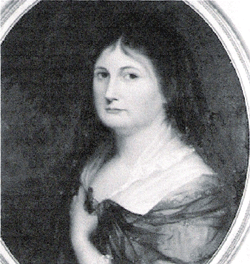 December 23, 1790 - just shortly before this move. “It was in large part due to his
(Isaac’s) persuasion that the move was made.” (ref. #2) Isaac had acquired a great deal of land in Fayette
and Bourbon counties of Kentucky as a ‘grant’ (reward) given by the government
for service in the Revolutionary War.”(ref. #174) December 23, 1790 - just shortly before this move. “It was in large part due to his
(Isaac’s) persuasion that the move was made.” (ref. #2) Isaac had acquired a great deal of land in Fayette
and Bourbon counties of Kentucky as a ‘grant’ (reward) given by the government
for service in the Revolutionary War.”(ref. #174)
In a
section written by Thomas Green (quoted in Rev. Hayden’s Virginia Genealogies,
p.43) it is recorded: “Isaac Webb enlisted in the Revolutionary Army at the age of
17, served to its close, attained the rank of Captain, and received land from Virginia. ‘Lieut. Isaac Webb, of the Continental line,
received on January 13,1784, 2,666 & 2/3 acres of land for three years service; also
an annual pension from May 31, 1833, until his death.’ ” (ref. #174
& 334) This land
was extensively in Kentucky, covering a tremendous amount of space. In an original family letter, it was stated that
Isaac Webb “at that time, owned nearly all the land Cincinnati was built upon and a
great part of the land Lexington was built upon.” (ref. #2)
Even
though there had been a lot of preparation made beforehand and “several of the men
had been out before clearing the land and preparing a shelter for them on land near where
the city of Lexington now stands,”(ref. 3) it was
still a major undertaking to relocate so many people through a part of the country that
was still very unsettled. We know now that
Lucy was pregnant with her first child by the time they left, and Mary (usually called
Polly) had just recently delivered her first baby and was traveling with a three month
old. Polly would often tell her daughter Nancy
how “her oldest child (Fannie, born Dec. 20,
1791) was but three months old when they came to Kentucky. They descended the Ohio in flat boats in momentary
apprehension of being attacked by the Indians.” (ref.
#174)
It is not clear how
long the journey took, but it is recorded in many places that they arrived on the
sixteenth of June 1791. (ref. #334) Thompson had already settled
near Paris, Kentucky. James II and Caty
homesteaded in Fayette County around Lexington on land “that James II
subsequently lived and died on.” It was
written later that “Charles lived near Versailles, George
in the homestead, Lucy Webb the adjoining farm, Polly Webb near Paris, and Catherine Scott
in Frankfort.” (ref.
#299)
After
accompanying his parents and siblings to Kentucky, James III then returned
to Virginia. Using the experience and money
that he had amassed during his time in Kentucky, James turned his hand to farming. In the fall of 1795, he married Elizabeth
Alexander, the daughter of Col. Morgan Alexander, an officer in the Revolutionary War. Her mother was Sarah Snickers Alexander and she
was the daughter of Elizabeth Taliaferro and Edward Snickers; a very wealthy planter and
landowner in Frederick County. (ref. # 292) The town of Bluemont was formerly named
Snickersville, and Snickers Gap (in the Blue Ridge Mountains) and Snickers Ferry were all
named for him. As many references state, “the village which grew up on the site of (Edward Snickers) farm was known as Snickers Gap
until 1824 when the State Assembly established it as a town and changed its name to
Snickersville. The name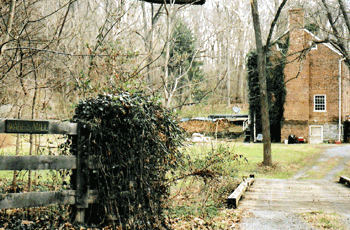 was discarded in favor of Bluemont
in 1900.” (ref.
#28) This was
an obviously wealthy and prestigious family in Virginia. Their son (Elizabeth’s brother) married Frances Washington, the daughter of
Warner and Mary (Whiting) Washington; first cousin of General George Washington. was discarded in favor of Bluemont
in 1900.” (ref.
#28) This was
an obviously wealthy and prestigious family in Virginia. Their son (Elizabeth’s brother) married Frances Washington, the daughter of
Warner and Mary (Whiting) Washington; first cousin of General George Washington.
James III was
twenty-five and Elizabeth was twenty-two years old when they married on November 10, 1796. (ref.
#292) “On November 10, 1803, four hundred and one
acres of Edward Snickers land was sold to them (James Ware and Elizabeth Alexander Ware)
for $14,011.00. This farm was 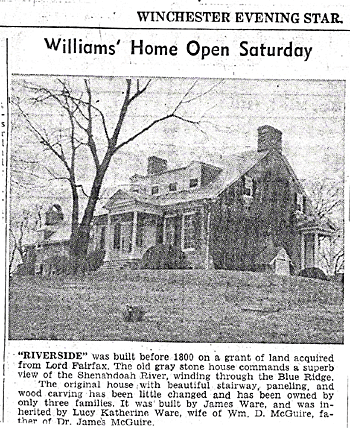 the heart
of old Edward Snickers enterprise, and it contained the ferry dock, the tavern, the
blacksmith’s shop, and at least one mill.” (ref.
#200) Edward Snickers’ legacy lived on when his
great grandson, Josiah William Ware (son of James III and Elizabeth), amassed another
great estate in land based in large part on his inheritance from his grandmother, Sarah
Snickers Alexander, who died in 1824.” (Ref.
#28)(Newspaper article Ref. #507) the heart
of old Edward Snickers enterprise, and it contained the ferry dock, the tavern, the
blacksmith’s shop, and at least one mill.” (ref.
#200) Edward Snickers’ legacy lived on when his
great grandson, Josiah William Ware (son of James III and Elizabeth), amassed another
great estate in land based in large part on his inheritance from his grandmother, Sarah
Snickers Alexander, who died in 1824.” (Ref.
#28)(Newspaper article Ref. #507)
James III and Elizabeth
built a lovely home called "Riverside" overlooking the Shenandoah River. Nestled at the foot of the Blue Ridge Mountains,
“it was considered a show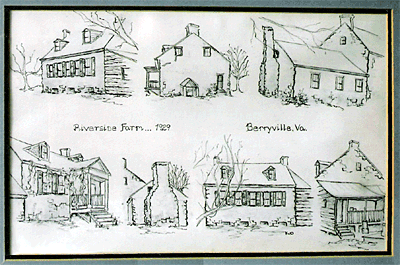 place for
miles around.”(ref. 2) Riverside was built out of gray
stone, was about a story and a half with dormer windows, and it was held in the family for
six generations. It still stands to this day. place for
miles around.”(ref. 2) Riverside was built out of gray
stone, was about a story and a half with dormer windows, and it was held in the family for
six generations. It still stands to this day.
James & Elizabeth
had three children that survived to adulthood; Sarah Elizabeth Taliaferro Alexander Ware
(born on Oct. 01, 1797), Charles Alexander Ware (born on July 03, 1800), and Josiah
William Ware (born on August 19, 1802.) Unfortunately,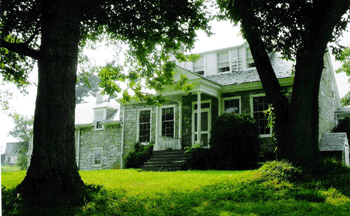 Elizabeth died on August
29, 1806, at the age of thirty-two. James
remarried several years later though. Elizabeth died on August
29, 1806, at the age of thirty-two. James
remarried several years later though.
Meanwhile, back in Kentucky,
the Wares and Webbs were establishing their new home there. Thompson Ware married Sally Conn and had twelve children. Mary (Polly) Ware Webb and her husband Charles went
on to have a total of eight children, although some died in
infancy. Lucy Ware 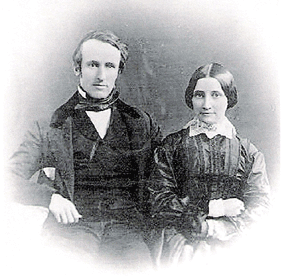 Webb and her
husband Isaac had nine children, and one of Lucy’s granddaughters (Lucy Ware Webb)
became the wife of Rutherford B. Hayes on Dec. 30, 1852. (ref. #411) Catherine Ware married a doctor named John Scott,
and they had five children. In the fall of
1793, Charles Ware left Kentucky for a while & went to live with his brother James
III. He “continued to do so almost until
the time he got married himself in 1803.” (ref.#35G) He then married
Frances Whiting, but they were never able to have any children. George Ware married Nancy Ferguson and went on to
have ten children. In
a letter written in 1812 by James Ware II to his son in Virginia, he wrote: “George
Ware is married at last to Mrs. Ferguson’s daughter; a close neighbor. . . he was
married the day I started from Frederick.” Webb and her
husband Isaac had nine children, and one of Lucy’s granddaughters (Lucy Ware Webb)
became the wife of Rutherford B. Hayes on Dec. 30, 1852. (ref. #411) Catherine Ware married a doctor named John Scott,
and they had five children. In the fall of
1793, Charles Ware left Kentucky for a while & went to live with his brother James
III. He “continued to do so almost until
the time he got married himself in 1803.” (ref.#35G) He then married
Frances Whiting, but they were never able to have any children. George Ware married Nancy Ferguson and went on to
have ten children. In
a letter written in 1812 by James Ware II to his son in Virginia, he wrote: “George
Ware is married at last to Mrs. Ferguson’s daughter; a close neighbor. . . he was
married the day I started from Frederick.”
It is not reported
whether James continued to practice medicine in his new home state, but he and Caty
prospered in Kentucky. Cornelia wrote “I
have been told that the Wares are very influential and wealthy in Kentucky.”(ref. #2) James obviously
traveled back to Virginia several times to visit because his letters (written on different
dates) speak of the traveling conditions. In one letter to his son James (in 1811) he wrote; “We got safe
home to this place in 16 days. All well -
horses held out well, the colt performed well. I’ve
got them now in Charles Ware stables – up to their eyes in the best of feed –
etc. We had a very good time; the roads were
good and fine weather.” (ref.#341)
He went
on to describe some of the circumstances in Kentucky at that time: “We have got the finest prospect just now for
a crop that I most ever see – all fine but flax.
It was dry a month or two ago which damaged flax. Your buzzard colt here is fine and very large
– (upwards of 15 hands high). She is not
halter broke yet – intend to do it soon when the weather is not too hot. Charles was sick, he says, last fall or he would
have had it done. I have got a large young
wagon horse. In a year or two more you may
have him if you want. Charles Ware has got one
(3 years past) that is nearly 16 hands and will fit a wagon to a tea. He intends to send him to you if he has an
opportunity. Charles Ware made almost 3 ton of
hemp last year and has sold it. Charles has
got the greatest prospect this year . . . wheat is very good.” (ref.
341)
In
another letter written by James II during this time period, he mentioned that
“Thompson talks of building a brick house. He
has paid 90 dollars and a horse toward it but has put it off until next year. Hemp is worth about six dollars now – it was
up for two weeks - only last winter were seven dollars.
I had a good deal of trouble with breaking my hemp, having taken it almost
all up before it was well rotted. Not
withstanding, it passed in great credit – I’ll know better next time. Our flak and oats will, I fear, not be worth
saving. Wheat is good. Corn is very low but looks very well. Your buzzard colt is very large and promising. I neglected to halter break her last fall but will
do it soon, and shall do it with great caution as I know the danger.” (ref.
#35B)
In yet
another letter from James II to his son James III (this one in 1812), he writes, “I
got here about 2 weeks ago and had a good time in riding.
The roads were better than I have ever seen them before. When I got to Chillicothe at Dr. Scott’s, I
stayed four days by reason for waiting for Betty Scott.
My horse was well pleased at the stay.” He
also reported that “George has got another fine colt out of his old mare – a
horse they call Peacemaker. She is now with
foul by Noxly; pedigree enough.” (ref.#298)
James and
Caty had 48 grandchildren, although some obviously did not grow into adulthood. In a letter dated December 25, 1825, their eldest
son Thompson wrote to his niece in Virginia (Sally Taliaferro Alexander (Stribling) that
“we have had twelve children – eleven living and eight of them daughters. Our youngest is a son – one year old. Our
families are all in Kentucky, except yours (referring
to James), where we can at least see one another
once or twice a year. And your Aunt Polly Webb
lives within a mile, where we can see each other every week.” (ref. #35E)
We know
from the same letter that Mary Webb (Polly) and Catherine Scott (Kitty) were widows by
December of 1815. Thompson wrote
““Your Aunt Polly Webb and Aunt Kitty Scott are both widows and I suppose will
never marry again.” Charles Webb had died
in 1806 and 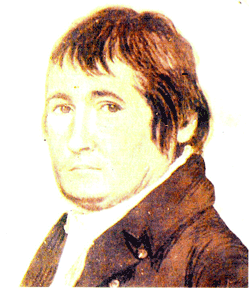 John M. Scott died on December 20, 1812. In research work done by William A. LaBach of Kentucky,
he states that “John Mitchell Scott was born in 1765. He married Catherine Ware.
John Mitchell Scott was a medical doctor. He was also Sheriff of Franklin County, Kentucky
and a Colonel in the Kentucky Militia in the War of 1812.” (ref. #
420) In a letter written by Cornelia Ware Anker, she
wrote: “Catharine Ware married Col. John M. Scott.
He must have been a splendid man; he is spoken of so many times with such
admiration.” (ref. #2) John M. Scott died on December 20, 1812. In research work done by William A. LaBach of Kentucky,
he states that “John Mitchell Scott was born in 1765. He married Catherine Ware.
John Mitchell Scott was a medical doctor. He was also Sheriff of Franklin County, Kentucky
and a Colonel in the Kentucky Militia in the War of 1812.” (ref. #
420) In a letter written by Cornelia Ware Anker, she
wrote: “Catharine Ware married Col. John M. Scott.
He must have been a splendid man; he is spoken of so many times with such
admiration.” (ref. #2)
Years
later, James and Caty’s granddaughter Lucy (child
of Lucy and Isaac) and her husband (Dr. Scott) obviously moved further out to the
country because her mother (Lucy Webb) wrote in a letter:
“She (Lucy) is so pleased
with raising so many fowls, she and Winny (both). I was up there two weeks ago, and I never saw the
like of the fowls in my life. I believe we had
150 turkeys and as many ducks and chickens. I
was all but distracted with the noise and fuss with feeding.
When I came home, I found a calm both in the house and yard; but for fowls
and children.” (ref.#25)
Life was
not easy in those years though, and (as with all families) James & Caty’s
children saw their share of worry and sorrow as well.
Their granddaughter Polly Ware (child of Thompson) died very suddenly after
the birth of one of her children. In a letter
written by his sister Lucy, she wrote, “I suppose you heard Thompson’s daughter
Polly Allen died very suddenly. Her child (baby Thompson ) was about 3 or 4 weeks old. She had been quite sick for two weeks, but Mary (her aunt) thought had gotten well. She (Polly) got up in the morning, put on her clothes, walked
to the fire, fell sick, was carried to the bed, and died in a few minutes. She left a son; her sister Kitty takes care of it
as if it was her own.” (ref. #25)
In the
same letter, Lucy wrote about Sally – another granddaughter of James & Caty and
daughter of Thompson. “Your Uncle
Thompson Ware’s daughter, Sally Russell, has been as ill as ever any person was, to
recover. She had a son and in three weeks was
taken ill with child-bed-fever. When her life
was despaired of by her physician, Dr. Innis, and every person that beheld her, they sent
for Dr. Scott. They kept him three days there. Your
Aunt (Polly) Webb went from here last week. She was satisfied that (Sally) would not have lived until morning. When Dr. Scott came, she said it really appeared
like raising the dead. Sally was taken with
strong convulsion fits in an hour after he got there – which lasted nearly two days;
one after another. But before he came away,
she began to mend slowly and has been mending ever since.
She can now walk about the yard but not entirely come to her reason. I suppose your Aunt Ware (Thompson’s wife Sally) would have been
frightened almost to death had not Dr. Scott told them she would be quite childlike –
perhaps for two or three months.” (ref. 25) Sally died in 1884.
Since the time frame of this letter from Lucy is around 1829, Sally
obviously recovered well enough to live many more years.
Another
one of Thompson’s children had a lot of problems for as Lucy wrote, “ Charles
William I suppose never will walk a smart child. He
was taken sick and continued so for a year. His
head enlarged (opened) when he was sick at about two years old. He has never walked since; his head very large now. Whether he took too much calomel or what, I
don’t know.” (ref.
#25)
Although
the grandchildren by Kitty and John Scott seemed to do well in general, they too faced
tragedy in their lives. In one letter written
back to Virginia, it stated that: “Your aunt’s (Kitty’s) son, John, started three weeks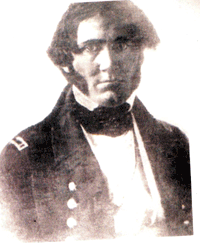 ago to West Point – there to finish his education.” He was a cadet at the academy from the dates of
July 01, 1830 to July 01,1835. According to
research done by Bill LaBach, “he served in the Florida War against the Seminoles in
1841. He served in the Mexican War and was
involved in the Battle of Monterey. . . he was brevetted to Major for gallant and
meritorious service in this battle.” (ref.
#420) Unfortunately, Major John Scott died at the young
age of 27. ago to West Point – there to finish his education.” He was a cadet at the academy from the dates of
July 01, 1830 to July 01,1835. According to
research done by Bill LaBach, “he served in the Florida War against the Seminoles in
1841. He served in the Mexican War and was
involved in the Battle of Monterey. . . he was brevetted to Major for gallant and
meritorious service in this battle.” (ref.
#420) Unfortunately, Major John Scott died at the young
age of 27.
Another
grandchild (child of Kitty and John Scott), Elizabeth, who was also called
“Betsy” or “Eliza,” married well and had a quite renowned husband
named Col. Solomon P. Sharp. Solomon served in
the House of Representatives as a Congressman and developed an esteemed reputation for his
work. In what was to become an infamous story,
Solomon was assassinated in his own home right in front of Eliza. There are many references to this historical
tragedy. In a letter (dated December 25, 1825)
from Thompson Ware to his niece Sally Stribling, he wrote:
“Your cousin, Betsy Sharp, lost her husband the 1st Sunday in
November last by a midnight assassin. He was
stabbed in the abdomen in his own house at 1 or 2 o’clock and expired without
speaking a word in a few minutes in the midst of his family.
The night before the Legislature was to meet (he was a member), a man was taken up
on suspicion and sent for further trial. Poor
Betsy was quite deranged for several days; she has since recovered and has come to her
right mind. She has three children – a
daughter and two sons. Mr. Sharp has left her
a sufficient competency for her support; he had a very severe spell of sickness last
summer which caused him to make a will and he left Betsy everything except two farms, as I
am informed.” (ref.
#35E)
Hayden also wrote about
this event in his book stating, “Colonel Solomon Sharp was assassinated on November
06, 1825 . . . John C. Calhou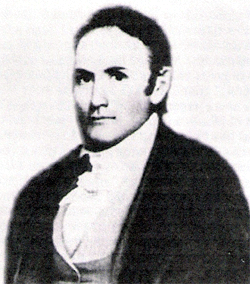 n said ‘he was the ablest man of his age
that had ever crossed the mountains.’ ” (ref.# 6) The author, H. Levin, also described the incident in
great detail when he wrote that Solomon “was cut down in the dead hour of midnight! Mr. Beauchamp called him from his bed to the door,
asking shelter for the night and using the name of an intimate friend to lure him and to
shield his own identity. While extending one
hand to his victim in simulating friendly greeting, with the other he thrust the deadly
knife into Colonel Sharp's body and fled away into the darkness of the night, leaving him
expiring on the threshold of his hospitable home! No
event in the history of Kentucky had been more tragic, none had so stirred the state, nor
indeed the nation, for Solomon P. Sharp was no ordinary man, and his service in Congress
had given him a national reputation.” (ref.# 421) n said ‘he was the ablest man of his age
that had ever crossed the mountains.’ ” (ref.# 6) The author, H. Levin, also described the incident in
great detail when he wrote that Solomon “was cut down in the dead hour of midnight! Mr. Beauchamp called him from his bed to the door,
asking shelter for the night and using the name of an intimate friend to lure him and to
shield his own identity. While extending one
hand to his victim in simulating friendly greeting, with the other he thrust the deadly
knife into Colonel Sharp's body and fled away into the darkness of the night, leaving him
expiring on the threshold of his hospitable home! No
event in the history of Kentucky had been more tragic, none had so stirred the state, nor
indeed the nation, for Solomon P. Sharp was no ordinary man, and his service in Congress
had given him a national reputation.” (ref.# 421)
The year
1833 was an especially terrible year for both the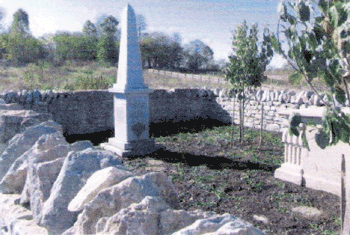 Webb and
the Ware families. There was a horrible
cholera epidemic that struck the region, and both families suffered extraordinary losses. In the household of Mary (Polly) and Charles Webb,
they lost their son-in-law (Nancy’s husband), Dr. Innis, on June 18, 1833.(pictue is ref.# 499) Webb and
the Ware families. There was a horrible
cholera epidemic that struck the region, and both families suffered extraordinary losses. In the household of Mary (Polly) and Charles Webb,
they lost their son-in-law (Nancy’s husband), Dr. Innis, on June 18, 1833.(pictue is ref.# 499)
The
hardest hit was the family of Lucy and Issac Webb. Their
grandson William Nicholson Scott (from daughter Winny) 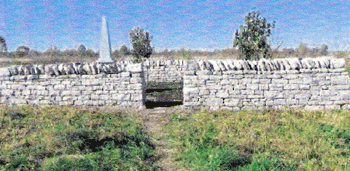 contacted cholera and
died on May 04, 1833. (pictue is ref.# 500) Lucy,
herself, got cholera and died on June 22nd, and just four days later, her
husband Isaac died on June 26, 1833. Their son
James Webb succumbed to the disease in July 1833, and daughter Winny Scott (the one who
lost her son to cholera in May) died of the same on July 08, 1833. Edward Webb (son of
Isaac Webb) also died in 1833, and later on September 07, 1833 – grandson James (from
Winny Scott) also died of cholera. contacted cholera and
died on May 04, 1833. (pictue is ref.# 500) Lucy,
herself, got cholera and died on June 22nd, and just four days later, her
husband Isaac died on June 26, 1833. Their son
James Webb succumbed to the disease in July 1833, and daughter Winny Scott (the one who
lost her son to cholera in May) died of the same on July 08, 1833. Edward Webb (son of
Isaac Webb) also died in 1833, and later on September 07, 1833 – grandson James (from
Winny Scott) also died of cholera.
In a
letter written to President Hayes from Isaac Scott (grandchild of Lucy and Isaac Webb and son
of their daughter Winifred and M.T. Scott) he wrote in reference to James Webb, “He
died at my father’s (M.T. Scott) house
during the terrible scourge of the cholera in July 1833.
I sat by his bedside and nursed him during his illness of 8 days and nights
– never taking off my clothes as there was so many sick we could not get help. We had four sick at he same time. My mother (Winnie)
died a few days before Uncle James.” (ref.#296)
The Hayes
Memorial Library has a paper where the following incident was reported. Mary Ann Todd Webb (Mrs. William T. Nicholson) relayed this story to
her daughter, Isabelle Eugenia Nicholson in 1876.
“. . . [In 1833] Sister Winny’s infant was
not two weeks old when news came of the death of her parents and her brother reached her. She was kept in so much terror of cholera (because) all the bank officers had died of cholera
– (except Mr. Scott [her husband] and one
other,) and he [was] called upon to
write wills of persons who had cholera. When
Betsey was told of the death of Papa, Mama, & Isaac, she (without thinking) ran into
Sister Winnie’s room and said, ‘O, Sister, Ma, Pa, & Isaac are dead.’ Sister lost all reason though Dr. Scott went to her
and said, ‘Winnie, you are not sick but frightened.
I assure you, you are not sick’ . . . and when brother was told, he
exclaimed in anguish, he ‘had killed them all.’ ”
Winnie
died shortly thereafter. “Maria [Cook
Webb] took the baby who was William and weaned Lucy [Lucy Webb Hayes] who was two years
old. The cholera was at its height at that
time.” (ref.174)
Between the months of
May and September in that year, they buried eight of their family members from this
dreaded disease.
In Kentucky,
there was a marker placed on the gravesite in commemoration of this time that reads:
“Isaac
Webb Sr. his wife Lucy Ware
of
Frederick County Virginia 1792
and
some of their sons and daughters
who
died in epidemic of 1833. This burying
ground
restored by their descendants in 1931.” (ref.
#417)
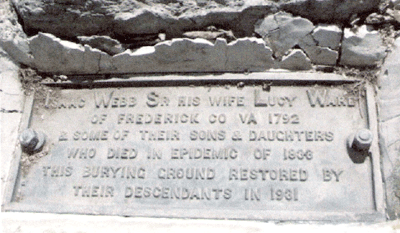
Tragedy
struck again in 1844 with the death of James and Caty’s grandson, Charles Henry Webb;
along with his daughter Cassandra (Cannie) Webb. Both
died in a horrible accident aboard the steamboat called the “Lucy Walker” which
was wrecked by explosion. According to a
letter from his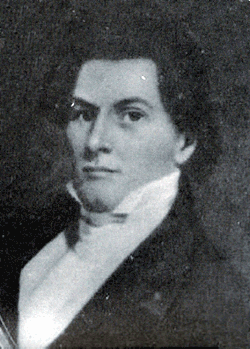 granddaughter, Augusta
Ford Andrews (daughter of Augusta Ware Webb Ford), the following occurred: “Every year my mother's father, Charles Henry
Webb, Jr., M.D., went to visit his mother Polly Todd Ware, (Mrs Charles Henry Webb, Sr.). In 1844, as per schedule, he took the trip leaving
his wife (who was expecting a child) and the two youngest children at home. He
left the two oldest girls in school in Lexington, Ky. On the way back there was an
explosion on board the boat and a fire. Dr. Webb was seriously injured and although
gotten ashore, he died before his wife could get there; also one of the daughters was
drowned.” The two daughters with
Charles were Cassandra (called Cannie) and Nancy Winifred (called Nannie). One was eleven and the other one was twelve years
old. When the explosion happened, the girls
got separated from their father and ended up on a mattress floating in the water. When the sparks from the burning boat ignited the
mattress, the girls were forced to let go. Cannie
drowned, but Nannie was rescued by a passing rescue boat.
When word got to Charles’ wife (Cassandra) that both her husband and daughter
were dead but Nannie was still alive, she traveled by horseback to retrieve her even
though she was pregnant at the time. Once she
delivered her baby, she named the little girl Cassandra after the daughter she had lost. (ref.
472) (Courtesy of Sandra
Walker) granddaughter, Augusta
Ford Andrews (daughter of Augusta Ware Webb Ford), the following occurred: “Every year my mother's father, Charles Henry
Webb, Jr., M.D., went to visit his mother Polly Todd Ware, (Mrs Charles Henry Webb, Sr.). In 1844, as per schedule, he took the trip leaving
his wife (who was expecting a child) and the two youngest children at home. He
left the two oldest girls in school in Lexington, Ky. On the way back there was an
explosion on board the boat and a fire. Dr. Webb was seriously injured and although
gotten ashore, he died before his wife could get there; also one of the daughters was
drowned.” The two daughters with
Charles were Cassandra (called Cannie) and Nancy Winifred (called Nannie). One was eleven and the other one was twelve years
old. When the explosion happened, the girls
got separated from their father and ended up on a mattress floating in the water. When the sparks from the burning boat ignited the
mattress, the girls were forced to let go. Cannie
drowned, but Nannie was rescued by a passing rescue boat.
When word got to Charles’ wife (Cassandra) that both her husband and daughter
were dead but Nannie was still alive, she traveled by horseback to retrieve her even
though she was pregnant at the time. Once she
delivered her baby, she named the little girl Cassandra after the daughter she had lost. (ref.
472) (Courtesy of Sandra
Walker)
Despite
the deaths and losses, both the Webb and Ware families did flourish and grow. Most of their children lived to be fairly old. Thompson died at the age of 83. James III only lived to be 50, Lucy was 60 before
she came down with cholera, but George lived to be 70.
As of now, there is no known date for the death of Virginia Catherine (Caty)
Todd Ware, but we know that letters and records show that “James Ware died about 1820
in Fayette County.” (ref.#
296) That
means that he lived to be 78 years old!
As it
stands today, from our particular branch of the Ware family tree, . . . the first son of James I was James II. James II had a son named James III. His first son was Josiah William, and Josiah’s
first son was James Alexander Ware. James
Alexander Ware had a son named Somerville and Somerville Ware had a son named James Nathan
Ware. James Nathan had an only son named James
Halm Ware, and this James went on to have 2 sons of his own; Kevin and David Ware. The oldest son Kevin has already had two sons
(James Connorey Ware and Cian Thomas Ware) so . . . . the name goes on! (ref. #1,
274, & 380)
References:
#1 The Ware Family
Bible – This is kept in my home and has dates and names recorded in it that go all
the way back to the early 1700’s.
#2 Original long letter of Cornelia Ware Anker (1945).
A goldmine of first-hand, intimate
family facts & remembrances. Cornelia was
the daughter of Sigismund S. Ware (son of
Josiah William Ware). She personally
transcribed some family letters (written between 1799 and 1831) that had been passed on to
her, and then added her own memories and recollections of family history.
#3 Second letter of Cornelia Ware Anker (1948) entitled THE WARE FAMILY IN CLARKE COUNTY Some repetitions of the first letter, but also some
new information.
#5 Wares of Virginia by Frances C. Griffin (as
collected from Virginia Genealogies by
H.E. Hayden) This is a compilation of information that Frances Griffin obtained from the
book “Virginia Genealogies” and mailed to me.
Her address (many years ago) was 1313 Butts Station Rd. Chesapeake, Virginia.
#6. Glassell/Ware
Genealogies – Information from a book entitled: VIRGINIA GENEALOGIES: A genealogy of the
Glassell Family of Scotland and Virginia by Rev. Horace Edwin Hayden, M. A. (It is also a history of the Ball, Brown, Bryan,
Conway, Daniel, Ewell, Holladay, Lewis, Littlepage, Moncure, Peyton, Robinson, Scott,
Taylor, and Wallace families.) Printed in Wilkes-Barre,
Pennsylvania in 1891 – copyrighted 1885. The entire book is dedicated to Mrs. Elizabeth
Alexander McGuire (nee Ware-Britton). * We own
the original copy of this book.
#25 Letter from Lucy Webb to her niece, Sarah (Sally
Elizabeth Taliaferro Stribling and her nephew, Josiah William Ware - - written June 5
(possibly 1830’s). Transcribed by
Judy Ware. This letter contains MUCH valuable
information of the Ware family members that settled in Kentucky.
#26 GLASSELL -Copy of a letter written from Sigismund
Stribling Ware to Sarah Ware on August 9, 1930.
Sarah then added lots of information to it that she had gleaned from research
for the DAR. Lineage facts for all the Wares;
even how Lucy Balmain got her name.
#27 Handwritten lineage
page – author unknown. Old family notes
found in box with old letters & photos. The
writing dates back to the late 1800’s or early 1900’s. Lineage back to James I and Agnes Nall.
#28 Snickers Acquires His Fortune – taken
from Clarke County Records Tells how
Snickersville got its’ name, links with George Washington, JAMES WARE & all his
propery, & origins of Springfield. Excellent
source for James Ware III and his home, tavern, and mill, etc.
#33 Excerpts of WARE genealogical information
from the 1960 Edition of the Wilder & Connecting Families in the Southeastern
United States
by: William M. Wilder.
#35E Letter from Thompson Ware to his niece, Sarah
(Sally) Elizabeth T. Ware. Thompson was the
brother of her father (James III) and the son of James II.
Transcribed by Judy Ware
#35G Letter from Charles Ware to his niece Sarah (Sally)
Elizabeth Taliaferro Ware Stribling written in 1831. It contains valuable family history. Charles was the son of James II and Catherine Todd
Ware. Transcribed by Judy Ware
#60 Genealogy chart of the Ware Family –
microfilm copy. This was found in a box of old
records held in the barn at the old family farm.
#70 Map showing the location of Riverside – home
of James Ware III & others- - Berryville, Virginia 1968
#80 Family register of births, deaths, marriages, etc.
– Taken out of Lena Ware’s family bible.
#114 Small handwritten piece of paper found in the
family letters with information about Morgan Alexander & Sarah Snickers (also mentions
Agnes Nall).
#141 Letter from George W. Williams (a cousin) to Josiah
William Ware on January 21, 1827 – right before his marriage to Frances. Very flowery and funny letter extolling the merits
of love and romance. Transcribed by Judy Ware
#155 Ancestral chart given to me by the Hayes
Library in Fremont, Ohio.
#173 WARE biographical information given to me
from the President Rutherford B. Hayes Presidential Center – dating way back
to James Ware I and Agnes Nall.
# 174 Large personal and biographical information (with
charts) on the WARE lineage - given to me by the Hayes Presidential Center.
#200 Edward Snickers, Yeoman by Ingrid Jewell Jones Lots of good information on James Ware,
Josiah Ware, and Springfield & how it came into the Ware family.
#202 Clarke County Historical Association pages
– showing marriage dates ( 1790 - 1820’s) – particularly James Ware &
Elizabeth Alexander.
#203 Information on James Ware III documented in Clarke
County Historical Association Proceedings Volumn IX
1949 copyright 1950 printed by Blue Ridge Press, Berryville, Va.
#255 Clarke County Historical Association
Proceedings Volumn VII Information on
James Ware and the land he owned.
#272 Clarke County Historical Association
Proceedings: Berry’s Ferry Early
information on James Ware
#274 Brief Overview of the Lineage of Josiah William
Ware, written by Judith Cumbea Ware, posted on website for Ware Genealogy – dated July 11, 2002
#292 Page from Clarke County Historical
Association Proceedings (no specific
volume listed) – page 12. Information on
Morgan Alexander and his wife Elizabeth.
#296 Letter from Isaac Webb to Rutherford B. Hayes (his
cousin) on Nov. 29, 1883. Transcribed by Judy
Ware
#298 Letter written by James Ware to his son James III
on Nov. 04, 1812. Transcribed by Judy Ware.
#299 Letter from Josiah Ware to R. B. Hayes dated July
16, 1876. Lots of information on past family
history (i.e. his father and grandfather) Transcribed by Judy Ware
#307 Letter written by James P. Riely of the County
Court in regards to a request made by President Hayes for information on the Ware and Webb
families. Transcribed by Judy Ware
#320 Page from a Clarke County historical book that
mentions land owned by James Ware (i.e. Chapel Run)
#322 Proceedings of the Clarke County Historical
Association “The History of Millwood Mill 1782-1785” Volume XVI 1969-1970
#334 Extra loose pages from VIRGINIA GENEALOGIES: A
Genealogy of the Glassell Family of Scotland and Virginia by Rev. Horace Edwin Hayden,
M. A. Printed in Wilkes-Barre, Pennsylvania in 1891 – copyrighted 1885. Some information is repetitive, but some
handwritten notes were added to the margins around 1930.
#341 Letter written from James Ware II to his son, James
III on June 16, 1811 postmarked David’s
Fork, Fayette County, Kentucky Transcribed
by Judy Ware
#380 Ware Family Bible by Judith Cumbea Ware, posted on
website for Ware Genealogy
#386 Last Will and Testament of
James Ware I – 1796
#411 Information on
Rutherford B. Hayes and his wife, Lucy Ware Webb Hayes obtained from the pamphlet to
Spiegel Grove Library in Ohio
#417 Copy of a photo of
a grave marker for Isaac Webb & Lucy Ware Webb; 1792 ( taken by John Woods in 2005)
#420 Research and writing done by William A. LaBach of Kentucky
on John Mitchell Scott – husband of Catherine Ware.
Posted March 17, 2006 on family website.
#421 Lawyers and Lawmakers of Kentucky, by: H.
Levin, editor, 1897. Published by Lewis
Publishing Company, Chicago.
#440 Complete Lineage of the
Ware Name to the Present Generation (through descending males) written by: JC Ware posted on
dated: April 2004
#472 Stories and information lovingly preserved by Sanda
Walker – a descendant of Augusta Ware Webb Ford (i.e. Mary Todd “Polly”
Ware via James Ware II). These facts and
treasured pieces of oral history were passed down to Sandra from her grandmother.
#499 Photo of newly renovated cemetery for the Ware/Webb families in
Kentucky - taken by Susie Stahl
#500 Photo of newly renovated cemetery for the Ware/Webb families in
Kentucky. Taken in 2006, this photo was taken and is owned by Susie Stahl.
#507 Newspaper article written about Riverside;
accompanied with photograph. Printed in the Winchester Evening Star on May 7,
1954. Article entitled "Williams' Home Open Saturday"
|

